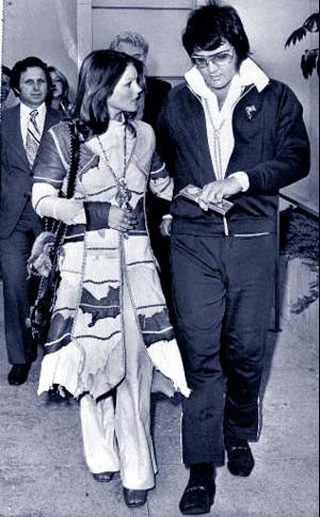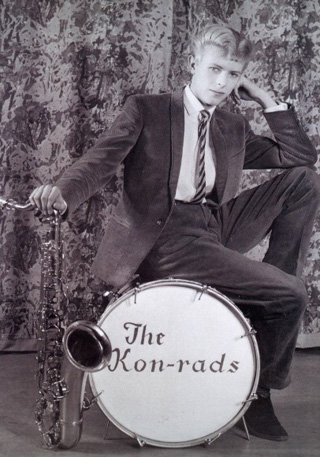
October 1973... Rock & Roll dies!
The last progressive movement in Rock & Roll history is Glam rock. On July 3, 1973, David Bowie announces at the Hammersmith Odeon arena that we have witnessed the final performance of 'Ziggy Stardust and the Spiders From Mars' (thus the reason filmmaker D.A. Pennebaker was there to film it). But that wasn't really true. Bowie would have to align himself with his birthday mate, Elvis Presley, for those last few romantic days in Rock and Roll to give way to its final, decadent period, which would be known as "Punk".
Let us consider the October 1973 divorce of Elvis and Priscilla Presley.
Let us consider the divorce of the word 'rock' from the word 'roll'.
Elvis and Priscilla's divorce coincides with the final October appearance of Ziggy (divorced from the Spiders) in the "1980 Floor Show." Bowie's 1974 record "Diamond Dogs" is not just a strained attempt to adapt George Orwell's "1984", it is failed attempt to "rock" altogether. Bowie struggles to create Rock & Roll without the Spiders, turning to Tony Visconti for a total re-mix, and eventually abandoning the cause for 'white soul'. It wasn't just Orwell's widow that was mucking up the legal rights to "1984", it was the very culture itself, which had killed Rock & Roll the year before. Bowie was singing about a wasteland that would be inhabited by the coming Punk culture.
Bowie fans showed up for the Diamond Dogs tour expecting Ziggy/Alladine Sane. After all, genius-artist Guy Peellaert gave us the greatest image Bowie image of all time for the record cover. But note that it is a "Ziggy" under visible metamorphosis with hands crossed like the Mona Lisa. Once inside the arena, one was treated to a floor show with David in a suit. This wasn't 1972 or 1973 Rock & Roll. No wonder Bowie said "This ain't rock and roll, this is genocide!"
By his October divorce, Elvis does not need to release relevant music anymore. It is his life which is now (and always was) a metaphoric guideline for everything relevant that happened within Westen pop culture. For instance, Rockabilly dies in November 1955, when Elvis signs his RCA contract. Rock & Roll first dies in 1958, when Elvis 'divorces' the Blue Moon Boys and goes in the Army. Look at any year in Elvis's life and find the progressive original pop culture reference (wherein 1956 is that dividing center.)
In 1973, the Golden Age of American Pop Culture has four years left of dying, to alter a phrase from Ziggy's song "Five Years". During the mid-1970s, “Rock & Roll” became a self-conscious and mass-marketed term, so much so that in order to survive as a RELEVANT art form, it split into two categories: Glam Rock and Punk Rock, as the genre prepared to go underground to survive it's nuclear winter, it's 'genocide'. You could say that Rock & Roll survives throughout the seventies due to desperate measures which resulted in a genius re-branding. The reaction to disco forces a pretty glam Bowie into an ugly Sid punk (though the hairstyles are the same).
On his October 1, 1974-released Stax recording "Raised on Rock", Elvis is singing in the past tense. "and Roll" has been removed from the title. These 4 years (1973-1977) of a dead Rock & Roll culture do not suit Elvis very well. In fact, this lack of respect for his defining genre, and Elvis' intellectual failure to embrace punk, explain his return to gospel; and ultimately, his funeral.

By November 1973, ‘Rock & Roll’ becomes ‘Rock’. The integrated primal beat gives way to the descending drum roll. It can be said that Led Zeppelin's pre-'73 records are Rock & Roll, and its post-73 records are “Rock”. Let us not forget KISS, the epitome of “Rock”, who formed in a very premeditated way in the fall of 1973. Kiss's job is to synthesize and gentrify Marc Bolan through Paul Stanley, remake Alice Cooper though Gene Simmons, and transmogrify Ziggy and the Spiders via "Space Ace" Frehley. Finally, mid-western teenage America was ready for the moral and sexual ambiguity of the New York Dolls, as long as it was anybody else.
Funk seizes the black rhythm that the white boy long hairs had abandoned and self-segregates into their own arena rock experience. Funk is Rock & Roll without the ‘rock’. Rock is Rock & Roll without the 'roll'.

The last true Rock & Roll album from the Glam era is Iggy Pop and the Stooges’ Raw Power. Bowie treated it like a stepchild when he produced it and relations were strained when the LP was released early in 1973. Because of its high-profile, stripped-down nature and primitive influence, Raw Power becomes the first Punk rock album. Its affiliation to Bowie ends Ziggy Stardust as much as Diamond Dogs. The city of Detroit had been name dropped on Aladdin Sane, but it was Raw Power that takes Rock & Roll energy away from England and back to America, if only to cause a second phase of garage rock (known as "Punk" - which then bounces back to England. But not before spreading through Manhattan, Cleveland, and yes, back to Memphis.
Just in time for Elvis's funeral.
If Elvis's divorce kills Glam, then it is Elvis' funeral that kills Punk. But in Punk there is constant redemption and rebirth.
What about the rest?
The rock band Queen tries hard to be a Rock & Roll band early on but they can't. That was their headliner Mott the Hoople's job. Queen's first record appears in 1973 and it's a commercial failure. 1974 suits them much, much better. Queen's rock-out of “Little Queenie” at the end of “Now I'm Here” on Sheer Heart Attack is more for nostalgia, whereas Marc Bolan's "Little Queenie" riff near the end of "Get It On/Bang A Gong" on Electric Warrior is eerily alive and potent in 1971. Consequently, Chuck Berry's last hit record (My Ding-a-ling) was in 1972. Much like Elvis, it was impossible to have a hit Rock & Roll record in a post-73 world where Rock & Roll no longer existed, unless you no longer existed. Bowie escapes the problem of the pervading trend altogether by becoming a keyboardist, hiding with Iggy during the Station to Station tour in 1976. It would seem that Bowie needed Raw Power to stay alive until 1977 would both end and begin a new cycle with Heroes and Iggy's Lust For Life.
Three of the most indelible images in music from 1977 are the Kelly Freas fantasy re-painting for Queen's News of the World cover, Jamie Reid's God Save the Queen record cover for the Sex Pistols, and the photograph of Elvis Presley (the king) laying at peace in his coffin on the cover of the National Enquirer (the equivalent to News of the World). All these images mock death. Death (or divorce) is nothing more than a shedding of layers so that one comes back to the music (life) as a new bride.
But the image and 'method of delivery' of Elvis dead in a casket is so decadent, so devastating, that it takes the entirety of American pop culture with it, even Punk. To have been a kid (as I was at 14) and hear of Elvis' death on television was to my untrained ears, the very death of music and the first time I had seen old clips or began to understand what my parents had experienced. I argue that the darker hard-core punk scene is a psychic response to the death of Elvis, especially with its straightedge, anti-drug message.
With the death of Elvis, the entirety of pop culture begins a massive slow-down, and by 1984, everything is on 'repeat' and progression is a memory. The last cycle of any dead period becomes its constant. Punk saves Rock & Roll forever by becoming its conscience.
Mike McCarthy
September 2014